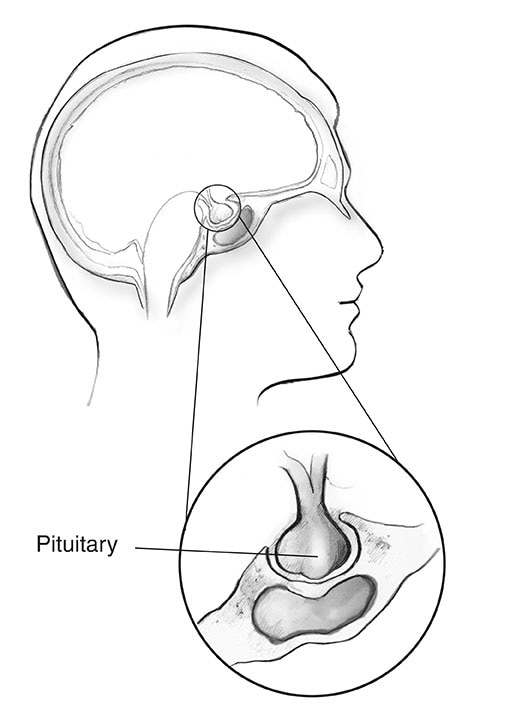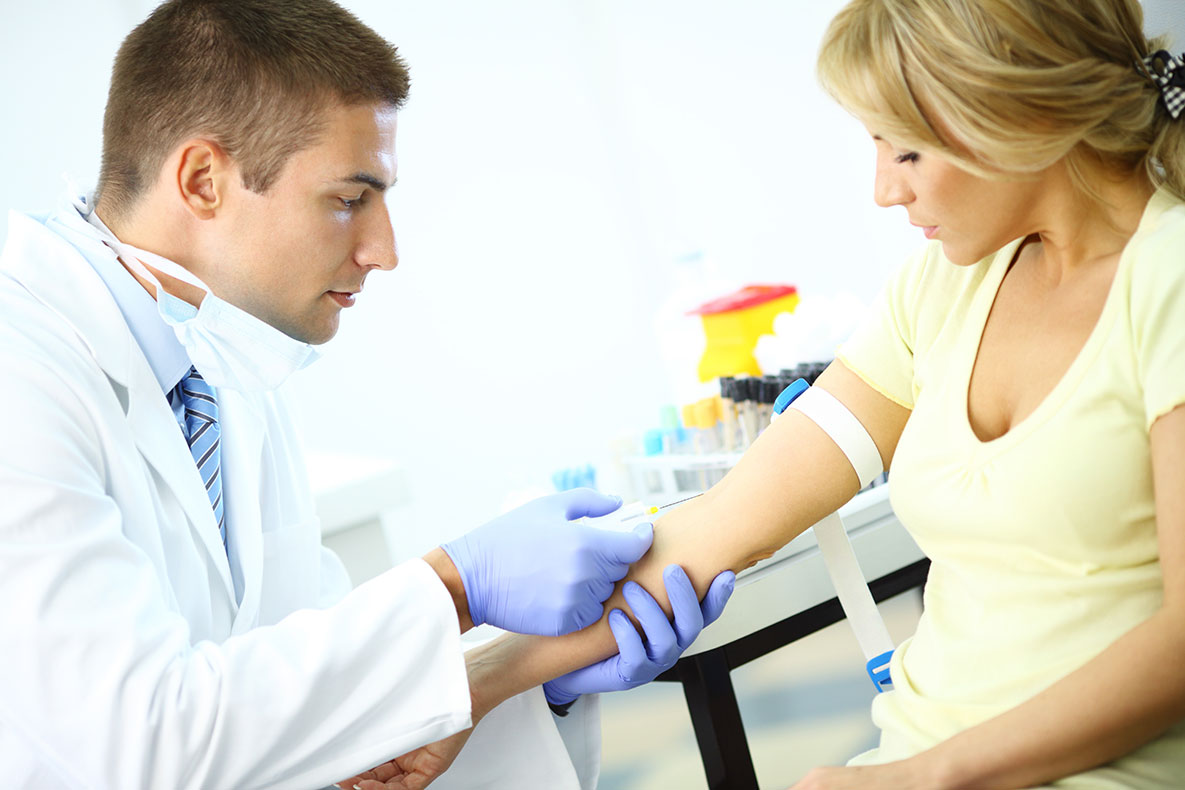Natural Things to Do to Get Your Pituitary Gland to Function Again
On this page:
- What is a prolactinoma?
- How common are prolactinomas?
- Who is more likely to develop a prolactinoma?
- What are the complications of having a prolactinoma?
- What are the symptoms of having a prolactinoma?
- What causes prolactinomas?
- How practise doctors diagnose prolactinomas?
- How do doctors treat prolactinomas?
- How exercise doctors treat prolactinomas during pregnancy?
- Clinical Trials for Prolactinoma
What is a prolactinoma?
A prolactinoma is a beneficial (noncancerous) tumor of the pituitary gland that produces a hormone called prolactin. Located at the base of the brain, the pituitary is a pea-sized gland that controls the production of many hormones.
Prolactin signals a woman's breasts to produce milk during pregnancy and breastfeeding. Having too much prolactin in the claret, a condition called hyperprolactinemia, can cause infertility and other problems. In most cases, prolactinomas and related health problems can exist successfully treated with medicines.
 The pituitary gland sits at the base of the brain.
The pituitary gland sits at the base of the brain.
How common are prolactinomas?
Small-scale, beneficial pituitary tumors are fairly common in the general population. A prolactinoma is the most common type of pituitary tumor, making up near 40 percent of all pituitary tumors.i
Who is more likely to develop a prolactinoma?
Women are more probable than men to develop a prolactinoma. These tumors rarely occur in children and adolescents. In children, prolactinomas may prevent the start or block the progression of puberty.
 Prolactinomas occur more than often in women than men.
Prolactinomas occur more than often in women than men.
What are the complications of having a prolactinoma?
Having a prolactinoma can lead to unlike symptoms and problems among women and men. Some of these are caused past having too much prolactin in the torso, while others are linked to the size and location of the tumor.
Excess prolactin, or hyperprolactinemia, can lower levels of sex hormones in both women and men. Related complications can include
- infertility
- bone loss (osteoporosis)
Prolactinomas are usually small, less than 1 centimeter in diameter. These small tumors are chosen "microprolactinomas." Less usually, a tumor may grow to more than i centimeter in diameter. These larger tumors are called "macroprolactinomas." Macroprolactinomas may press confronting nearby parts of the pituitary gland and the brain. Complications can include
- vision issues, caused when the tumor presses on the optic nerves or optic chiasm, the part of the encephalon where the two optic nerves cross over each other
- headaches
- low levels of other pituitary hormones, such as thyroid hormones and cortisol
What are the symptoms of having a prolactinoma?
Amidst women, mutual symptoms of having a prolactinoma include
- changes in catamenia, such every bit irregular periods or no periods
- infertility
- milky belch from the breasts, also called galactorrhea
- loss of interest in sex
- hurting or discomfort during sex due to vaginal dryness
Among men, common symptoms include
- loss of involvement in sex associated with low levels of testosterone
- erectile dysfunction
Women often written report symptoms earlier than men considering they may observe changes in their periods or milky discharge from their breasts when they are non pregnant or breastfeeding. But women who are taking sexual practice hormones—in birth control pills or hormone replacement therapy—may non experience these changes.ii The same is true for women who accept reached menopause and no longer take periods. Amongst these women, and amongst men, a lack of clear signs and symptoms may lead to a delayed diagnosis.
What causes prolactinomas?
Almost pituitary tumors develop on their own. The cause of these tumors is unknown. In some cases, genetic factors may play a role. For case, the inherited disorder multiple endocrine neoplasia type ane increases the risk for prolactinomas.
What else tin crusade prolactin levels to rise?
Prolactin levels ordinarily rise during pregnancy and breastfeeding. They may also ascension slightly at other times because of1
- physical stress, such every bit a painful blood draw
- exercise
- a meal
- sexual intercourse
- nipple stimulation
- injury to the chest surface area
- epileptic seizures
These increases in prolactin are commonly small and temporary. Other than a prolactinoma, the factors that nearly often atomic number 82 to excess prolactin in the blood are medicines, illnesses, and other pituitary tumors.
Medicines. The brain chemical dopamine helps curb the production of prolactin in the body. Any medicine that affects the product or use of dopamine tin brand prolactin levels rise.
Medicines that can increase prolactin levels include some types of
- antipsychotic medicines, such as risperidone, only not others, such every bit clozapineiii
- high claret pressure level medicines
- drugs used to treat nausea and airsickness
- hurting relievers that contain opioids
Although the hormone estrogen stimulates the release of prolactin, estrogen-containing nativity control pills and hormone replacement therapy have non been found to crusade hyperprolactinemia.4
If high prolactin levels are because of a medicine, these levels will usually return to normal three to 4 days after the drug is stopped.
Other illnesses. Illnesses that may increase prolactin levels include
- kidney disease
- an underactive thyroid, or hypothyroidism
- shingles—particularly when lesions touch your chest
Other pituitary tumors. Other big tumors located in or near the pituitary gland may likewise raise prolactin levels, usually past preventing dopamine from reaching the pituitary gland.
Sometimes the cause of excess prolactin is unknown.
How do doctors diagnose prolactinomas?
Doctors diagnose prolactinomas based on the results of ii tests
- Blood exam. The prolactin blood exam volition measure the level of prolactin in your claret. If the level is too high, your doctor will social club an imaging test to detect a possible tumor.
- Imaging tests. The preferred examination is the magnetic resonance imaging (MRI) scan, which uses radio waves and magnets to create detailed images of your internal organs and soft tissues without x-rays. If an MRI is not a adept option for you lot (for example, if you have a pacemaker or other implant that has metallic), your dr. may lodge a computed tomography (CT) browse instead. The results of the imaging test commonly will let your doctor to ostend a diagnosis of prolactinoma and determine its size and location.
 A blood examination is used to detect loftier levels of prolactin.
A blood examination is used to detect loftier levels of prolactin.
After confirming the prolactinoma diagnosis, your doctor may acquit other tests to discover out if the tumor is affecting other hormones. Depending on the tumor's size, your doctor may also enquire you to take a vision test.
How practise doctors treat prolactinomas?
Doctors usually treat prolactinomas with medicines. More rarely, surgery or radiation therapy may be used. The goals of treatment are to
- bring prolactin levels back to normal
- shrink the tumor
- make sure the pituitary gland is working properly
- correct any problems acquired by the tumor, such every bit menstrual issues, milky discharge from the breasts, low testosterone levels, headaches, or vision problems
Medicines
Medicines called dopamine agonists command prolactin levels and compress the tumor very finer. These drugs mimic the furnishings of the brain chemical dopamine.
Two dopamine agonists are nigh commonly used to treat prolactinomas
- bromocriptine, a drug that must be taken twice or 3 times daily
- cabergoline, a drug that can exist taken in one case or twice per week
Cabergoline is the preferred drug for treating prolactinomas, because it is more than effective than bromocriptine and has fewer side effects.one
Outcomes. For almost small prolactinomas, dopamine agonists bring prolactin levels dorsum to normal and shrink tumors in iv out of 5 patients.v
Side effects. Common side effects of the drugs include nausea, vomiting, and dizziness. Both medicines should always be taken with nutrient. Starting handling at a low dose and taking the medicine at bedtime can reduce side furnishings.
Complications. Although dopamine agonists take been linked to eye valve impairment, these problems were found mainly amid people taking these medicines to treat Parkinson'south illness. These patients typically accept much higher doses (usually almost x times higher) of these medicines than are used to treat prolactinomas. If you need to accept a high dose of a dopamine agonist, your doctor may order an echocardiogram (echo) to check your heart valves and heart function. Rarely, psychiatric disorders related to impulse control, such as compulsive gambling, have been seen in people taking these medicines.half dozen
Duration of treatment. Y'all may have to take these medicines for a long fourth dimension to prevent the tumor from growing back, especially if the prolactinoma is big. Later on 2 years, the medicines may be slowly reduced and stopped if prolactin levels are normal and the tumor is no longer visible.1 Simply if your prolactin level goes back up again, you may demand to go back on the medicine for as long every bit needed to bring your prolactin level under control.
Surgery
Although doctors virtually often treat prolactinomas with medicines, in some cases surgery may be an option. Examples include
- you can't tolerate the medicines
- the medicines aren't working for you
- you take antipsychotic medicines that interact with the medicines used to treat prolactinomas
In some cases, when a prolactinoma is large, a woman may choose to have surgery to remove the tumor before trying to become pregnant.
Ii types of surgery may be used
- Transsphenoidal surgery is most commonly used to treat prolactinoma. The surgery is done through an incision, or cutting, at the back of the nasal cavity or under the upper lip.
- Transcranial surgery is used more than rarely if the tumor is large or has spread to other areas. The surgeon removes the tumor through an opening in the skull.
Outcomes. The success of the surgery depends on many factors, including
- skill and feel of the surgeon
- size and location of the tumor
When done by an experienced surgeon, the surgery corrects prolactin levels in about 90 pct of people with small tumors and 50 percent of those with large tumors.vii For people with larger prolactinomas that can just be partly removed, medicines often can return prolactin levels to a normal range after surgery.
Side effects and complications. Side furnishings of the surgery tin include
- low pituitary role, or hypopituitarism
- temporary diabetes insipidus, a condition that leads to frequent urination and excessive thirst
- cerebrospinal fluid leak
- local infection
Radiation
More rarely, if medicines and surgery fail to reduce prolactin levels, radiation therapy may exist used. This blazon of treatment uses high-energy x-rays or particle waves to impale tumor cells. Depending on the size and location of the tumor, the total radiation dose is delivered in one session, or in lower doses over the course of 4 to six weeks.
Outcomes. Prolactin levels return to normal in one out of iii patients treated with radiation therapy.1 However, as radiation treatment lowers prolactin levels over time, it may take years to reach this upshot. Your physician is probable to prescribe medicines while you expect to see results.
Side effects and complications. The almost mutual side effect is low levels of thyroid hormone. In upwardly to half of patients, radiation therapy may also lead to a decrease in other pituitary hormones.8 Vision loss and brain injury are rare complications. Rarely, other types of tumors tin can develop many years afterward in areas that were in the path of the radiation beam.
How do doctors care for prolactinomas during pregnancy?
Earlier pregnancy. Having a prolactinoma may make it difficult for y'all to become significant, but handling with dopamine agonists is very constructive in restoring fertility.
 Apply of dopamine agonists is commonly stopped once a pregnancy is confirmed.
Apply of dopamine agonists is commonly stopped once a pregnancy is confirmed.
When pregnancy is confirmed. Although studies propose that both bromocriptine and cabergoline tin can exist safely taken in the early stages of pregnancy, bromocriptine is typically preferred because of its longer safety record.one As soon every bit your pregnancy is confirmed, your dr. will usually advise you to stop taking these medicines to prevent whatsoever possible effects on the fetus.
During pregnancy. Prolactin levels normally increase during pregnancy, preparing your breasts to make milk after your baby is built-in. The pituitary gland oft doubles in size during pregnancy. Your prolactinoma may also grow in size, especially if it is already large. If you begin to accept symptoms such every bit headaches and changes in vision, your doctor may recommend that y'all start taking the medicine once again.
Afterward delivery. After delivery, women with small prolactinomas can usually nurse their babies. If your prolactinoma is big, your dr. may suggest that you consult with an endocrinologist about breastfeeding.
Doctors don't ordinarily mensurate prolactin levels during pregnancy and breastfeeding. Your doctor will unremarkably begin to do so again a couple of months afterward yous stop nursing. In some cases, prolactin levels remain normal after delivery and nursing.9
Clinical Trials for Prolactinoma
The NIDDK conducts and supports clinical trials in many diseases and conditions, including endocrine diseases. The trials look to detect new ways to prevent, notice, or treat affliction and improve quality of life.
What are clinical trials for prolactinoma?
Clinical trials—and other types of clinical studies—are part of medical research and involve people like y'all. When y'all volunteer to accept part in a clinical written report, you assist doctors and researchers learn more about disease and improve health care for people in the future.
Researchers are studying many aspects of prolactinoma, including new treatments for this condition.
Notice out if clinical studies are correct for you.
What clinical studies for prolactinoma are looking for participants?
Y'all can view a filtered list of clinical studies on prolactinoma that are open up and recruiting at www.ClinicalTrials.gov. You tin expand or narrow the list to include clinical studies from manufacture, universities, and individuals; all the same, the National Institutes of Wellness does non review these studies and cannot ensure they are rubber. Always talk with your health care professional before you participate in a clinical study.
References
Natural Things to Do to Get Your Pituitary Gland to Function Again
Source: https://www.niddk.nih.gov/health-information/endocrine-diseases/prolactinoma